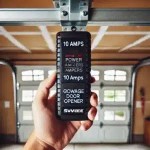Garage Door Dimensions for Two-Car Garages with a Focus on Linkous Openers
Selecting the appropriate garage door dimensions is a critical aspect of building or renovating a two-car garage. The dimensions not only affect the accessibility and utility of the space but also directly impact the functionality of the garage door opener, particularly when considering the specific requirements and features of a Linkous opener. Careful planning and consideration of several factors are necessary to ensure a well-functioning and aesthetically pleasing garage.
Garage door dimensions for a two-car garage are not standardized and can vary depending on several variables. These variables include the size of the vehicles intended for storage, the presence of storage space along the walls, and local building codes. Understanding the generally accepted dimensions, common variations, and the specific considerations for integrating a Linkous garage door opener is essential.
Standard Garage Door Dimensions for Two-Car Garages
The most common width for a two-car garage door is 16 feet (192 inches). This width allows for two standard-sized vehicles to be parked comfortably side-by-side. While 16 feet serves as a baseline, some garages, especially those designed for larger vehicles or additional storage, may opt for a wider door, such as 18 feet (216 inches). The additional width can be particularly useful in garages with limited space for maneuvering or where occupants frequently need to access items stored along the walls.
Regarding height, the standard garage door height is typically 7 feet (84 inches). This height accommodates most passenger vehicles, including SUVs and small trucks. However, if the garage is intended to house larger vehicles, such as full-size trucks or vans, an 8-foot (96 inches) or even a 9-foot (108 inches) door may be required. It is important to measure the tallest vehicle that will be using the garage and to allow for sufficient clearance. This measurement should account for any roof racks or other accessories that may add to the vehicle's overall height.
When determining the garage door dimensions, it is also crucial to consider the headroom required for the garage door opener's mechanism. Headroom refers to the space between the top of the door opening and the ceiling. Standard garage door openers typically require at least 12 inches of headroom. However, low-headroom openers are available for garages with limited vertical space. These openers often require as little as 4 inches of headroom, making them suitable for garages with low ceilings or obstructions.
In summary, for standard two-car garages, a width of 16 feet and a height of 7 feet are generally adequate. However, these dimensions should be adjusted based on the size of the vehicles, the amount of storage space required, and the headroom available. Consulting with a professional garage door installer can provide valuable insights and ensure that the chosen dimensions are appropriate for the specific needs of the homeowner.
Impact of Linkous Opener Features on Door Dimensions
Linkous garage door openers are known for their reliability and advanced features. These features can influence the selection of garage door dimensions. For instance, Linkous openers often come with safety sensors that require specific mounting locations and clearances. These sensors prevent the door from closing if an obstruction is detected, ensuring the safety of people and property. The positioning of these sensors can impact the overall dimensions of the door, particularly the height, as they need to be installed at a certain distance from the ground.
Moreover, Linkous openers often include features like battery backup, remote operation, and smartphone integration. These features require additional space for the opener unit and its associated components. The size and location of the opener unit need to be factored into the overall design of the garage. If the headroom is limited, a low-profile Linkous opener may be the best option. These openers are designed to minimize the amount of vertical space they occupy, allowing for the installation of a garage door in garages with low ceilings.
The type of garage door also affects the choice of Linkous opener. Sectional doors, which are the most common type, require a standard opener and track system. Roll-up doors, on the other hand, may require a specialized opener and track system. The weight and size of the door also influence the type of opener required. Heavier doors may require a more powerful opener, which may be larger in size and require more headroom. Linkous openers are available in various models, each designed for different door types and weights. Selecting the appropriate Linkous opener for the chosen garage door is crucial for ensuring smooth and reliable operation.
Furthermore, the insulation of the garage door can also affect the choice of opener. Insulated garage doors are typically heavier than non-insulated doors. This added weight can place a greater strain on the opener, potentially shortening its lifespan or affecting its performance. When choosing a Linkous opener for an insulated garage door, it is important to select a model that is specifically designed to handle the increased weight. Consulting with a Linkous dealer can provide valuable guidance on selecting the right opener for an insulated garage door.
It is imperative to review the Linkous opener's installation manual carefully. The manual provides detailed information on the specific requirements for installation, including the necessary clearances, mounting locations, and wiring instructions. Following these instructions precisely is crucial for ensuring the safe and proper operation of the opener.
Building Codes and Local Regulations
Local building codes and regulations often dictate minimum and maximum garage door dimensions. These codes are designed to ensure the safety and accessibility of buildings. Before constructing or renovating a garage, it is essential to consult with the local building department to determine the specific requirements for garage door dimensions.
Some building codes may specify minimum door heights to accommodate emergency vehicles or individuals with disabilities. These codes may also regulate the placement of safety sensors and other safety features. Failure to comply with these codes can result in fines or delays in construction.
In addition to dimensional requirements, building codes may also regulate the type of materials used in the construction of the garage door. For example, some codes may require that garage doors be made of fire-resistant materials or that they be able to withstand certain wind loads. These requirements are designed to protect the occupants of the building and the surrounding property.
Furthermore, local regulations may also address noise levels associated with garage door operation. Some communities have noise ordinances that restrict the amount of noise that can be generated by garage door openers. Linkous openers are generally known for their quiet operation, but it is still important to ensure that the chosen model complies with local noise regulations. This may involve installing noise-dampening materials or adjusting the opener's settings to minimize noise levels.
Obtaining the necessary permits and approvals before beginning construction is crucial. The permitting process ensures that the proposed garage meets all applicable building codes and regulations. It also provides an opportunity to address any potential issues or concerns before construction begins. Working with a qualified contractor who is familiar with local building codes can streamline the permitting process and ensure that the garage is built to code.
In conclusion, determining the appropriate garage door dimensions for a two-car garage involves considering several factors, including the size of the vehicles, the amount of storage space required, the headroom available, and the features of the chosen garage door opener, such as a Linkous opener. It is also essential to comply with local building codes and regulations. By carefully considering these factors, homeowners can ensure that their garage door is functional, safe, and aesthetically pleasing.

Commercial Garage Steel Buildings Sunward

Steel Commercial Garage Buildings In Utah Ut Sunward

Steel Commercial Garage Buildings In Utah Ut Sunward

Steel Home Buildings In Colorado Sunward Building

Steel Commercial Garage Buildings In Utah Ut Sunward

Steel Commercial Garage Buildings In Utah Ut Sunward

Rv Storage Building Kits Sunward Steel Buildings

Residential Steel Buildings Sunward
To Blackstone

Steel Home Buildings In Colorado Sunward Building
Related Posts








